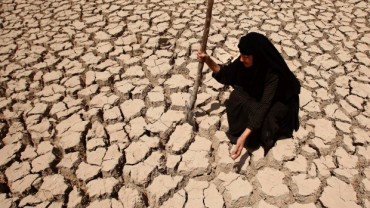 Oil rich Saudi is not the only country getting slack for greenhouse gas emissions. This Canadian writer points the finger at Canada, where tar sands are yet to be an issue at climate change talks.
Oil rich Saudi is not the only country getting slack for greenhouse gas emissions. This Canadian writer points the finger at Canada, where tar sands are yet to be an issue at climate change talks.
Climate activist groups have been attacking Saudi Arabia, saying the Middle East country is playing an obstructionist role at climate change talks. According to Derek Armstrong, from Persona Corp, Canada and their tar sands projects, should be the one taking a beating at this month’s climate change talks at Copenhagen. Armstrong has written a report on Canada’s failure to safeguard nature and people from the effects of the tar sands, not to mention the climate impact. Read on for the whole story:
“You can’t go for a walk in the forest without having an impact, because you left a footprint. That doesn’t mean you shouldn’t go for a walk in the forest,” Brian Ferguson, CEO, Cenovus Energy Inc., a company that owns interests in the Alberta tar sands development.
In these pre-Copenhagen days, Canada has become a bit of a whipping boy over its environmental record, especially regarding the Alberta tar sands, that vast (149,000 square kilometers) bleak area where forests have been clear-cut and the earth dug up to get at the black, oil-rich dirt.
Foreign journalists, politicians and environmentalists have attacked Canada for obstructing progress in reducing greenhouse gas emissions and for putting profit before care of the environment. George Monbiot of the Guardian wrote: “The immediate threat to the global effort to sustain a peaceful and stable world comes not from Saudi Arabia or Iran or China. It comes from Canada. How could that be true?”
How indeed? Canada a greater threat to the world than Iran?
It is well known that Canada is one of the world’s worst polluters, on a per capita basis, far worse than China or India, but Prime Minister Stephen Harper prefers to focus on a different statistic: with an estimated 178bn
barrels of oil reserves (counting the tar sands), Canada is second only to Saudi Arabia in the amount of oil it holds.
This is what he means when he says that Canada is destined to be an “energy superpower.” And despite falling oil prices due to reduced demand since 2008, and a rash of suspended or canceled oil recovery projects, the potential is there for hundreds of billions of dollars in oil revenue and millions of man-hours of employment.
This will depend to a degree on rising prices for oil—it is vastly more costly to extract a barrel of oil from tar sands than to pump it out of the ground—but no government could turn its back on that kind of potential wealth.
For this reason, according to Brian Ferguson of Cenovus Energy Inc., the entity created by EnCana Corp. to take care of its tar sands development, the governments of Alberta and Canada need to do more to defend their work against the environmentalist lobby and to educate Canadians about the importance of the resource for energy security and economic benefits. And at the Copenhagen conference, Harper has to make sure that world leaders and others understand the whole story, “not just sort of one side.”
Carbon Capture and Storage: the prime minister’s best defence
Part of that story will undoubtedly be Carbon Capture and Storage. The prime minister will certainly play the CCS card at Copenhagen to show that Canada is a “leading” player in the fight to clean up the environment, and he will point to the just-announced Alberta Carbon Trunk Line, the world’s largest carbon capture and storage pipeline, in Alberta.
The 240-kilometer pipeline will capture emissions and pump them underground, with the capacity to
transport 14.6 million tons of carbon dioxide emissions per year. This, officials say, is the equivalent of the emissions created by 2.6 million cars in a year. The line will form the backbone for a future network of
carbon capture projects, with new oil companies connecting to the network as needed.
This latest announcement comes a month or so after the two governments announced a carbon capture system to be developed with Royal Dutch Shell and a similar system at a coal-fired plant owned by TransAlta Corp. A fourth project is to be announced December 2, worth another $200 million. All together, the carbon capture projects represent about $2 billion in funding, proving, according to the government of Canada, that they are serious about this.
Natural Resources Minister Lisa Raitt declared that CCS technology was Canada’s “best chance to capture emissions.” It remains to be seen whether the systems will work. They have not been tested and the technology is new.
More importantly, there’s no guarantee the projects will actually go ahead. Even if they do, none will be operational until 2015 at the earliest. They will have no impact for at least five more years on Canada’s steadily rising emissions.
Tailing ponds: are they safe?
While the tar sands are seen as a major contributor to the problem of global climate change, what is not as likely to come up in Copenhagen is the effects of the exploitation of the tar sands on the environment and people in the immediate vicinity.
The most visible element of this local issue is the tailing ponds created to hold the massive amounts of spent water needed for the process of extracting oil from the sands.
As of June, 2008, according to a report entitled Watered Down: Overcoming Federal Inaction on the Impact of Oil Sands Development to Water Resources, 720 million cubic metres of toxic water sat in these tailing ponds, covering an area of 130 square kilometers. If these ponds are breached, or their toxic water seeps into ground and surface water, the results could be catastrophic for humans and wildlife.
There have already been wildlife kills, most prominently the deaths of over one thousand migrating waterfowl that landed in a pond. Of even greater concern is the effects of all this toxic water on the First Nations people who depend on the Athabasca River from which the water is diverted in the first place. There is mounting evidence that the people of Fort Chipewyan, Alberta, are dying in unusually high numbers of rare cancers. Fish caught in the river are showing tumours and other abnormalities.
Environment Canada says it is investigating whether the tailing ponds are in fact contaminating ground water, and Shell Canada, says all is well, with “no measurable effect on groundwater or river water.”
A Suncor spokesman assures us that the tailing ponds were designed by experts to prevent leaking, so they must be safe. Experts can’t be wrong, can they? Meanwhile, the Alberta Energy and Resources Conservation Board (ERCB) released rules in 2009 regulating the recovery of solid materials from the tailing ponds and requiring companies to submit management plans by September 30, 2009. Directive 074 of these rules concerns the removal of fine mineral solids from the water and the disposal of these solids in specially designated areas.
According to the authors of Watered Down, Harper’s government is failing to enforce existing laws protecting land, forests, water, fish, birds and wildlife and needs to take a much more active role in protecting the
environment from potential disaster.
They recommend that the government
• Establish enforceable standards under the Canadian Environmental Protection Act for key toxic substances created by oil sands activity.
• Lead a process to create a water-sharing agreement between itself and Alberta, the
Northwest Territories, Saskatchewan, and Aboriginal governments.
• Establish strict, enforceable, and protective limits on water withdrawals [from the Athabasca River].
• Conduct a comprehensive peer-reviewed assessment of the health impacts of industrial oil sands development on the residents of First Nations and Métis communities.
• Require the completion of a comprehensive cumulative effects assessment and establish binding limits that protect the natural environment based on that assessment.
• Identify and protect the habitat of listed species at risk in the region affected by oil sands activity.
• Implement the Migratory Birds Act and prosecute bird deaths on tailings ponds.
• Assume the leadership responsibility for monitoring the environmental impacts of oil sands development.
• Institutionalize proactive measures requiring oil sands operators to pay for the environmental damage caused to water resources.
• Set and adopt absolute targets for greenhouse gas reductions.
Quite a list when you consider that, according to the oil companies, there’s no problem at all.
Stephen Harper likes to talk about setting “realistic” goals for carbon emissions, goals that are achievable, not just fine-sounding. Most reasonable people would accept that approach. Better to promise something
you can do than promise something you can’t, provided that you intend to make good on the promise.
Yes, Canada is a bigger country to get around in than little England, so we use more energy for transportation; a colder country than Spain, so we need more heating oil; more dependent on fossil
fuel energy than Iceland. Canada is a developed country with huge infrastructure needs and certainly no politician would dare do anything that would threaten our standard of living.
These realities can’t be denied, but they can’t be used as excuses any longer to do nothing. Considering that
Canada’s emissions have steadily risen since it signed the Kyoto accord, an accord Stephen Harper repudiated from day one, it is time for Canada to finally do something—anything—to clean the tar off its face.




5 thoughts on “Canada Worse Than Saudi Arabia, Considering Tar Sands Impact on Global Warming”
Comments are closed.